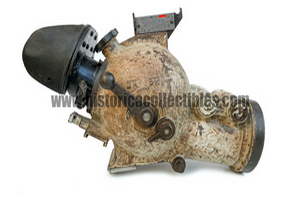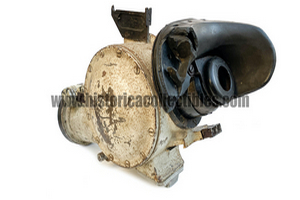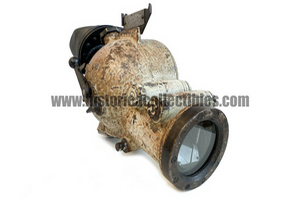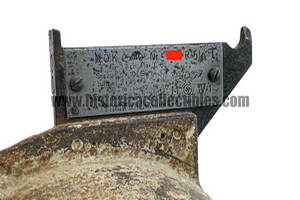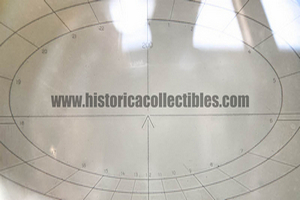Zieloptik 2x - 5x FLAK 3,7 cm Cannone C/36, Kriegsmarine, about 1944
Zieloptik or Optical Aiming Sight, with variable 2x and 5x magnifications, made by BLC (Carl Zeiss Jena) for the Kriegsmarine (German Navy) in about 1944.
This aiming optical sight is made up of a large ferrous metal structure, extremely robust and heavy (its weight reaches 18 kg) suitable for protecting lenses, prisms and related mechanisms inside it from the recoils caused by the firing of the artillery batteries, probably of the "quadrinata" type.
All external devices useful for its operation are built in such a way as to prevent any infiltration of rain, humidity or salt produced by sea water which, in a short time, would have caused corrosion to the internal mechanisms, compromising its reliability. These manufacturing prerogatives have made it possible for us to establish that this optical sight was used on the cannons installed on board the battleships of the Kriegsmarine probably from 1944, also taking into account the technical specifications reported on the identification plate, the encrypted name of its manufacturer: BLC (Carl Zeiss Jena), the type of gun C/36 and its 3.7 cm caliber FLAK.
Using the longer lever located on the right of its structure it is possible, by means of an optical-mechanical device placed inside, to select the two magnifications and more precisely, 2x40 and 5x10, both equipped with 2 filters that can be inserted using the shorter lever .
There is also a knob placed above the eyepiece with the function of snap selector, which allows the attendant pointer to choose between four independent elliptical reticles for the use of air defense to be used with the 2x40 objective, or 5x10 for anti-ship or anti-submarine fire.
This aiming sight is in excellent condition, all mechanisms work correctly.
We know of the existence of only one other specimen kept in a private collection.
Carl Zeiss takes its name from its founder, Carl Zeiss, who on November 17, 1846 chose the small city of Jena, in Thuringia, as the location for his precision optical equipment factory. Thanks to the strict quality control that Carl Zeiss imposed on its products, going so far as to personally destroy the microscopes that did not pass the tests, the newborn Zeiss became the official supplier of the University of Jena and received the gold medal of the industrial exhibition in 1861 of Thuringia as the best research instrument manufactured in Germany, awarded to the microscope Stand I of 1857.
In 1866, the thousandth microscope was produced and the Zeiss name became known in all European scientific circles. Thanks to the studies on the Porro prism, in 1893 Abbe patented a double prism binoculars, which accentuated the perception of depth. The mass production of Zeiss binoculars began in 1894, already at the beginning of the twentieth century more than 30,000 were made, by the beginning of the First World War the figure had risen to 500,000 and, by the end of the Second World War, 2,260,000 were produced binoculars for the civilian and military market. Models were made starting from 4x11 mm to 12x40 mm, up to real giants such as 80 mm and 100 mm. Thanks to studies conducted on the perception of light in low light situations, it was shown that the average dilation of the pupil in an adult is about 7 mm.
For this reason, the 7x50 mm model was introduced in 1910 and remained on the market until 1917 with few changes to the materials used. In 1926, following the post-war crisis of the First World War with the Treaty of Versailles which bankrupted many important German companies, Zeiss bought the "C.P. GOERZ" and founded the Zeiss Ikon in 1926. In 1937, Zeiss had commercial contacts and factories spread over 29 countries around the world. From 1933 Zeiss acquired interest from the Nazi regime, which balanced production towards military instruments. It successfully produced binoculars with wide-angle optics for military use, pressure resistant optical systems for U-boats, periscope binoculars for targeting tanks. Furthermore Zeiss cameras were mounted on the V2 for remote sensing operations of the English coasts.
On November 1, 1935, Zeiss, in the person of Alexander Smakula, patented a process for the treatment of optical glasses with extraordinary results in terms of light transmission. Remained a military secret until 1939, it was adopted on binoculars to reduce ghost images and internal reflections. During the Second World War, there were numerous bombings against the Zeiss factories. Jena was bombed several times by the Allies starting in 1944. Stuttgart was razed to the ground, although the Contessa-Nettel factory suffered little damage. The bombing of Dresden, in addition to devastating the city, also caused considerable damage to the Zeiss Ikon headquarters.
On April 13, 1945, American military forces entered Jena, surprising themselves as the bombings had not caused significant damage. The main planetarium was in ruins, while the factories remained operational.

